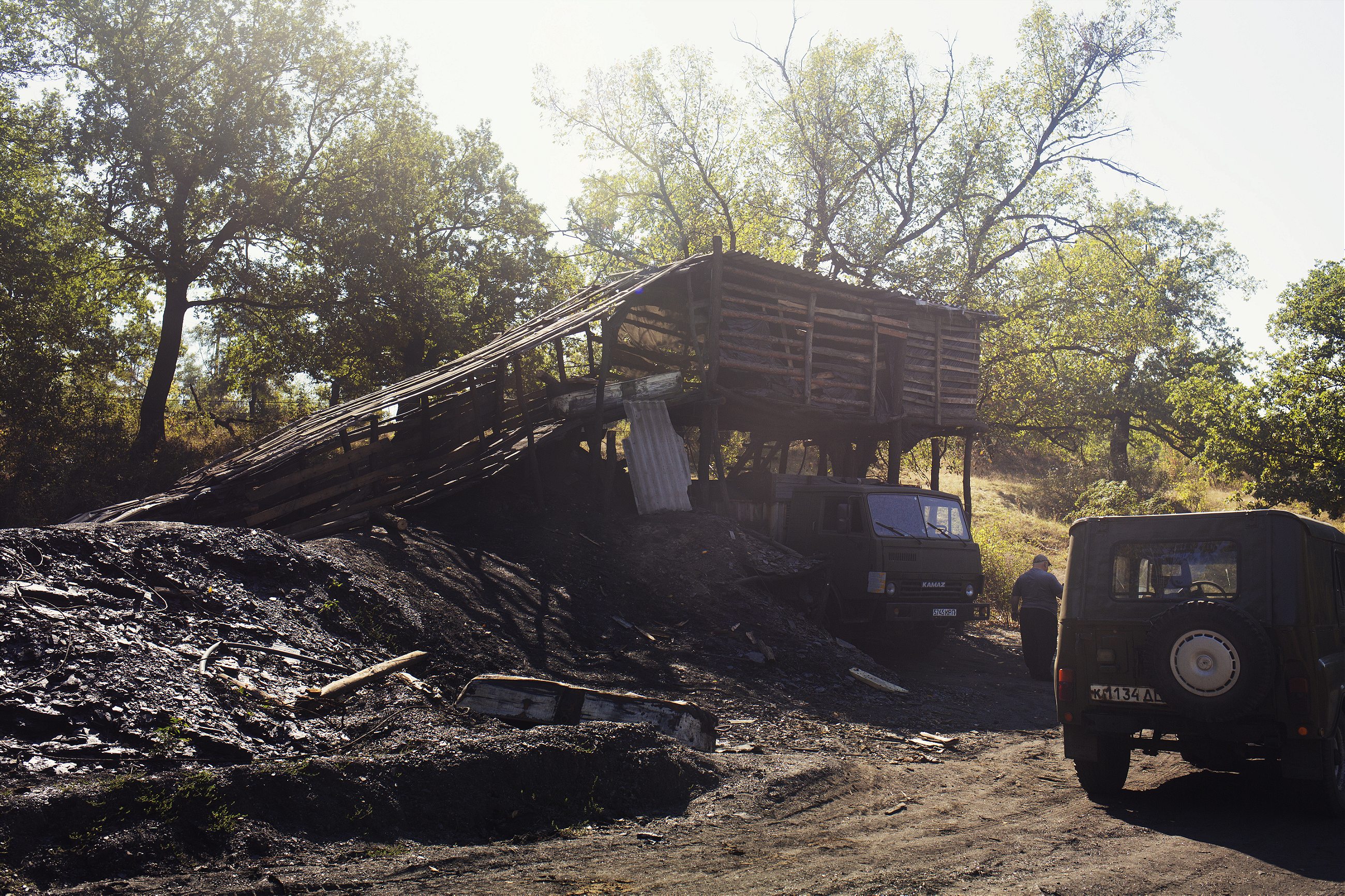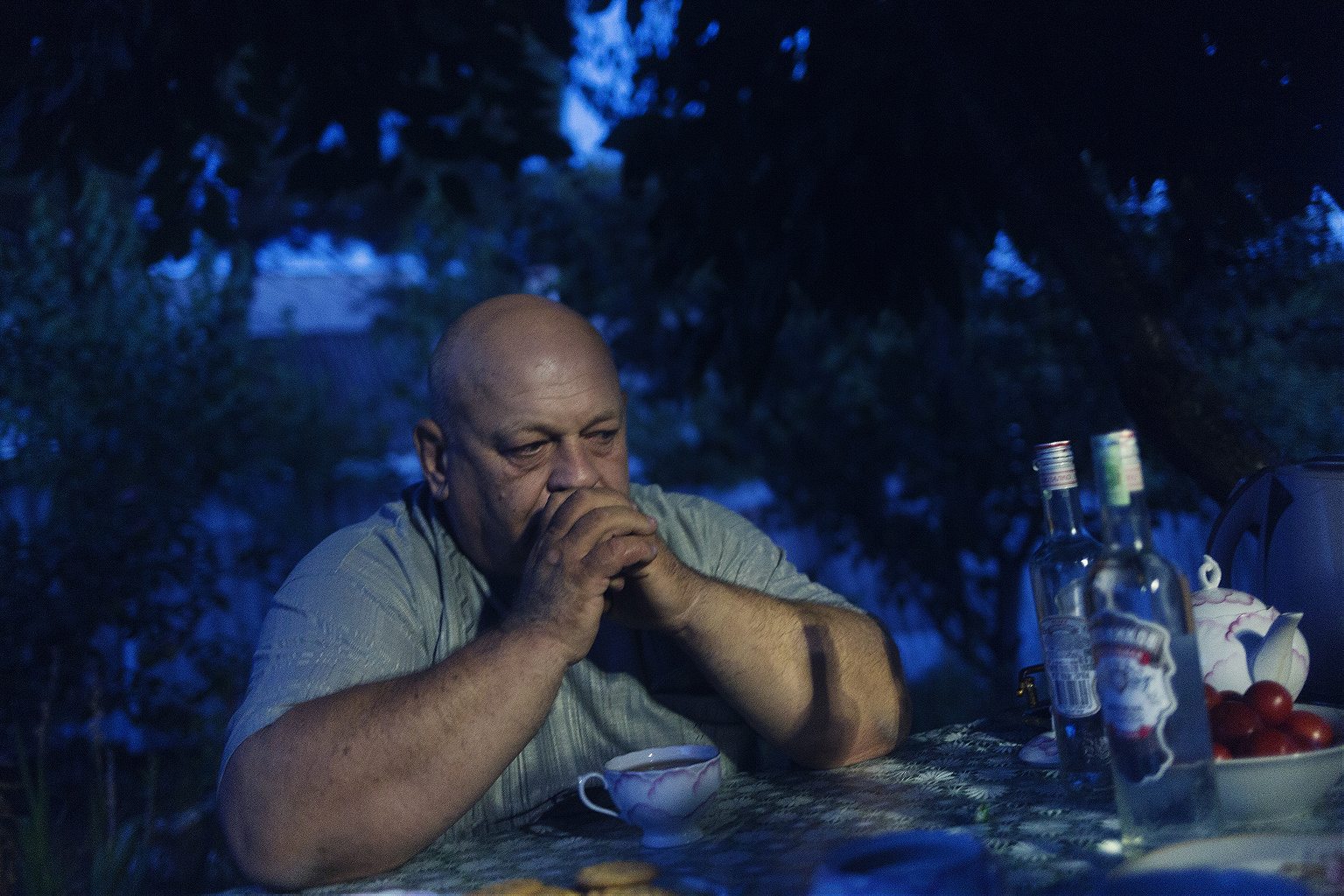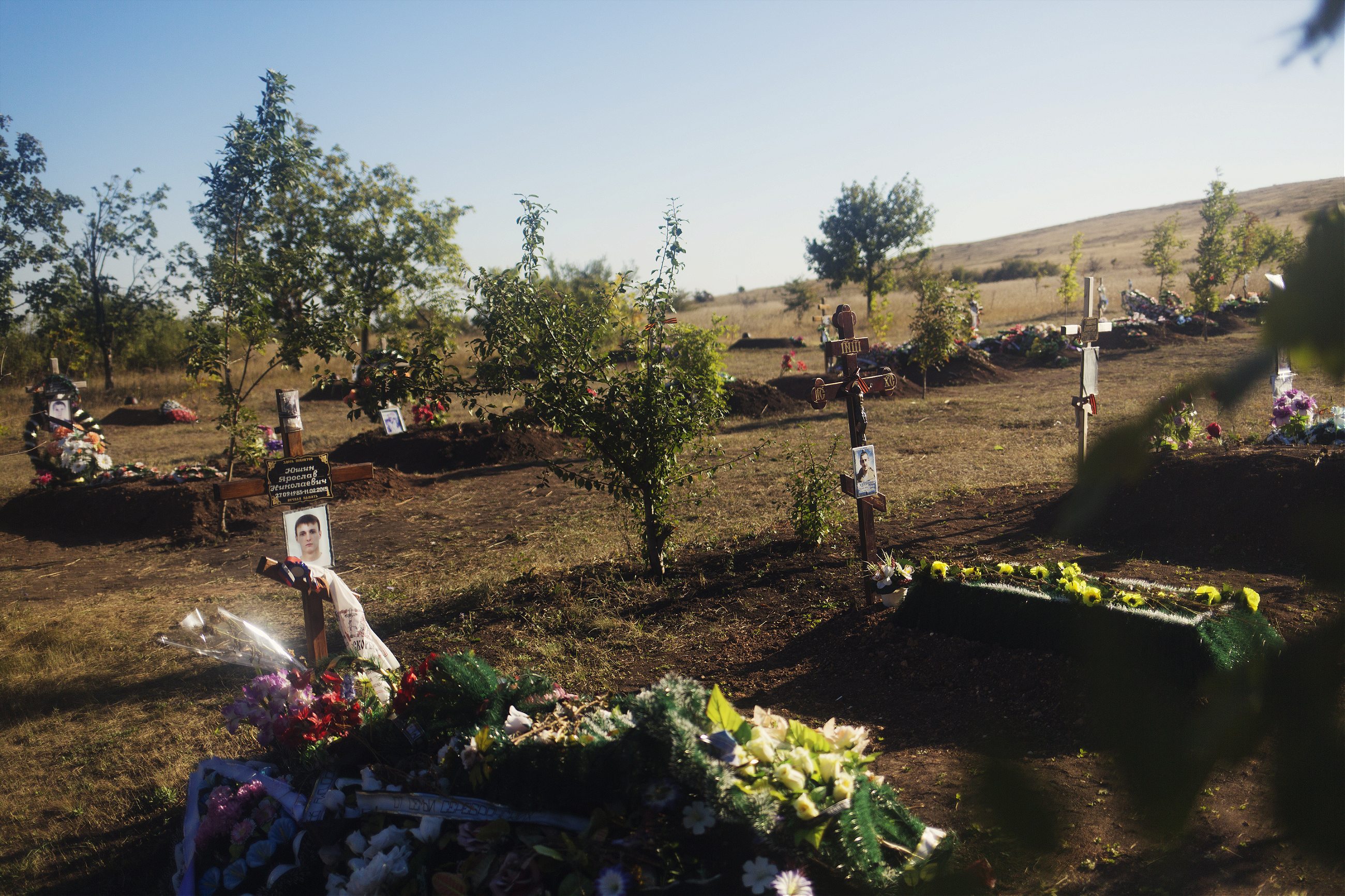Civil war has led to the legalization of a dangerous shadow industry.
SNIZHNE, Ukraine—
The darkness bred fear. Tolek Golovko tried to calm down as a wagon carried him 800 meters down into the mine. The boy was afraid the wooden pillars would fail and the ceiling would come crashing down on him and the rest of the group. That happens on a regular basis here in Eastern Ukraine. Most recently in March last year, 33 people were killed when a mine collapsed outside of Donetsk. That one was large and state-owned, so the news went global. But when illegal mines like the one in Snizhne collapse, it is not always reported. Instead, families are compensated, mines are closed—and they become another secret mass grave deep in the woods.
In other words, the 14-year-old had reasons to be afraid. “It was so dark, so cold, so wet. It was almost as if I couldn’t breathe,” Golovko recalls six years later, when we meet him after his shift. When he first arrived at the tiny mine in the woods of Snizhne, he came with a friend. They lied about their age, said they were 16 and that they were happy to work several days of the week. Little time was left for school.
“Both my friend and I needed the cash. He had recently made a girl pregnant, and I wanted money for my family,” he recalls. When we ask him what his parents thought of his new job, he simply answers: “They have always valued hard work.”

Snizhne is a town that has followed the Ukrainian coal industry’s economic roller coaster. Today, the Soviet housing blocks look empty and the streetlights remain dark during the night. But Lenin still stands proud on the main square; pro-Russian rebels took control of Snizhne after war broke out in the spring of 2014.
The big state-owned mines and the illegal operations in the woods have existed side by side here for decades. The former employ miners with degrees, provide social benefits and allow strong unions. In the woods, other rules apply. Conditions are much more dangerous, shifts are longer, and passages are narrower, but the inexperienced teens who work there are paid twice as much, despite having no education or training.
Until recently, these illegal mines quietly made up the shady side of the Ukrainian mining industry. But when Snizhne was taken over by the rebels and became a part of the self-proclaimed Donetsk People’s Republic, the mines were legalized. Boris Litvinov, a member of the DPR parliament explained to the New York Times last year that if the authorities were “to close hundreds of illegal mines—and there are hundreds of them—we would need to find other jobs.” He added that the new law would put an end to corruption and organized crime, which go hand in hand with the business of illegal coal mining.

Through the Russian social media platform VKontakte, we asked owners of the homemade mines to show us their newly legalized enterprise. A few days later, outside the mine office of Snizhne, we meet Aleksandr Vladimirovish Belois, a 6 feet tall and three feet wide giant of a man with hands like a bear. “Look here,” he growls. “These are a worker’s hands!” He pulls us into his car and squeezes us between him and the driver. The jeep sputters to life. We have no idea where we are off to.
During the 1980s and ’90s, when coal was the cornerstone of the economy, Belois was a miner in various state-owned mines in Snizhne. Records show that Ukraine produced 216 million tons of it in 1975. By 2013, only 61 million tons were being extracted. Those numbers have halved since the outbreak of the war. Four mines have closed in Snizhne and thousands of jobs have been lost as a consequence. Belois started selling toys, but when the war broke out in 2014, it became difficult to get the products over the front line.
“The mayor gathered us and said that it was time to open the mines. They had become legal now,” says Belois. He paid 40,000 rubles ($600) for a small piece of land in the woods, and promised the rebels he would pay a 2.5 percent tax on his revenue.
Belois doesn’t mind paying taxes. When Snizhne was a part of Ukraine, he explains, the owners of illegal mines would pay the same amount of money in bribes to police officers. “Legalizing the mines was a good move,” he says. “The money that once bribed policemen now goes to the state. Furthermore, safety is better regulated.” He throws his arms wide to underscore that he operates a legal business. In fact, he’s going to Donetsk later today to pay what the rebels call an “environmental tax.”
The jeep carries us just a few kilometers into the woods, where four miners work in the 26 foot deep mine. Wooden scaffolding, a dirty bucket that carries coal and miners alike, and a truck that transports coal to the market: This is all he needs to extract 110 tons of coal every month. Belois sells his coal for slightly more than $23 per ton, giving him a monthly revenue of about $2,500.
Belois says he has no idea what happens to his coal after it is sold on the market. But considering that more than half of Ukraine’s power plants need anthracite to operate and that all the coal mines producing it are located on occupied soil, there’s a good chance it ends up on the other side of the frontier. This would mean that the Ukrainian government is purchasing coal from the very rebels they are fighting.

“We export 90 percent of our coal to Ukraine,” confirms Nikolai Branislavovitsh Olshevsky, the technical director of the mines in Snizhne. “The last 10 percent, we use locally,” he adds, denying that the mines in the woods are part of that industry.
On the other side of the front line, Roman Vybranovsky, spokesman for Ukraine’s Coal and Energy Department explains in an email that they need coal from the rebels in order to provide energy to its citizens. “We also believe that we support the citizens of Ukraine in the terrorist-controlled areas by providing jobs,” he justifies, underlining that the trade takes place in an organized manner with a few selective mining companies that are officially registered on Ukrainian soil and use a Ukrainian banking system.
However, the industry has a history of whitewashing: mixing coal from the illegal mines with what they extract from the state-owned enterprises. The practice drastically lowers production costs at the expense of the safety of the workers. According to the investigative journalist Denis Kazansky, the output of whitewashed coal was $700 million in 2012.
Golovko, who has worked in the illegal mines since he was 14, doesn’t consider himself a victim of that system. He says he’s happy to have a job that pays reasonably well, and free coal to give to his mother.
“She didn’t let me go to war,” says Golovko. “I’m thankful for that now. I see how my friends return injured. And why should I run around and shoot?”

The sun is setting over the treetops as Golovko returns from his shift. For the past couple of weeks, he worked outside of the mine, shoveling coal and sending a sled down into the darkness. But he wants to go back underground. It’s uncomfortable and dangerous, for sure, but the pay is good.
A few kilometers away from the city center, we enter the underground world of the state-owned mine Zaira. “There are stories of a ghost of a miner haunting this place. His work team left him, and now he hammers on the walls for revenge,” whispers Mikhail Ivanov. We can barely see him in the glare of his headlight.
His face already bears black streaks, even though the elevator has hundreds of meters to go before reaching its final destination. The water is trickling. Our ears feel clogged.
At the bottom, the ground is covered with black mud. The oxygen masks hang heavy on our shoulders. The air is stuffy. Here, Ivanov works six hours a day without breaks. For a long time, miners were privileged in Eastern Ukrainian society. They were paid well, and the state-owned mines were rewarded with large amounts of subsidies that made up for the fact that one Ukrainian worker is five times less efficient than a Polish miner.

Back in his apartment, Ivanov places a bottle of vodka on the table. His wife, Tatyana, has prepared chicken and mashed potatoes. Ivanov talks about his early 20s, when he was a Soviet soldier in love. What does a marriage-seeking, young man do? Well, he tries to get a job. The father-in-law was a policeman, and he had connections. He could facilitate a lucrative job in the mines.
“Yes, well, people here get jobs by having connections,” says Tatyana, smiling apologetically.
The couple had two children, bought an apartment, and traveled to Crimea and Moscow on holidays. They treated themselves to fine cheeses and a new fridge. In short, they enjoyed economic independence. But recent inflation means that Mikhail Ivanov earns much less these days. He doesn’t complain. Unlike his 23-year-old son, he has a job. “He tried to work in the mines, but he quit.”

At dusk, we join Ivanov on his balcony for a cigarette. The sounds of kids playing on the corner of the block is preceded by his wife’s gentle nagging: “smoking, smoking, always smoking.” Ivanov takes a drag and exhales the smoke philosophically out of the balcony window. This was where he was when he saw the smoke coming from the Malaysia Airlines Flight 17 crash on July 17, 2014. A Dutch investigation recently concluded that the plane was shot down by a Russian-made missile, likely fired by rebel-controlled territory, but Ivanov thinks the Ukrainian military was responsible.
Two days before, Snizhne was heavily shelled by the Ukrainian army. “Eleven people died that day. One of whom was a 5-year-old boy,” he says.
The next evening, we are invited by Aleksandr Belois, the owner of the mine in the woods, to discuss our visit into his mine. But he has changed his mind. Belois has been to Donetsk, paid his tax, and gotten strict orders from the People’s Republic. “If anything were to happen to foreign journalists, we would be in a lot of trouble. We can’t risk that,” he relates.
Pouring tea and offering us biscuits, he looks at us with big, wet eyes. “My friends, listen to me. I would never send you to a place where I wouldn’t venture myself. My mines are safe, yes, but the other mines. … I would never send my friends down there.” We ask him what is more dangerous: being a soldier in the war or a worker in the mines. Belois takes a moment to think, and looks down at his bear paws. “Now that the war is raging at its worst, I reckon …. equally dangerous.”
